“Look down the road and you see people endlessly coming and going. Stand a moment and watch them. Where are they going? Why are they traveling? What do they carry? Whence have they come?” …from “Hawkers and Walkers in Early America”, by Richardson Wright, 1927; J. B. Lippincott Company.
Often serving as a town’s gathering place for governmental, social, and entertainment activities, the country tavern played a significant role in Federal period New England. There, the locals as well as travelers took part in great exchanges of news, information, opinion and even gossip. Many of the taverns were on stagecoach routes, there was a constant hustle and bustle of people coming and going. Lodging was usually offered, as well as good food and drink. Twenty five cents would buy you a warm meal, and twelve cents would get you a place to rest your head for the night!
After the Revolutionary War ended, thousands of miles of new improved roads were created. These improvements allowed itinerant peddlers, professionals, entertainers, and folk artisans, like the wall stencilers, brushstroke artists and scenic landscape muralists, quicker and easier access to the once isolated villages and farming communities throughout New England. Many roving itinerants passed through the taverns found in almost every town.
Such is the story of the c. 1817 David Damon Tavern, one of the “crown jewels” of historic North Reading, Massachusetts. In the days of horse drawn carriages and self-reliance, the Damon Tavern served as a bustling stagecoach stop, inn, and governmental and social epicenter of the rural farming town of North Reading. Located in the heart of North Reading’s historical district. The building sat at the intersection of two important stagecoach routes; the Lowell to Salem and the Boston to Haverhill routes. The Tavern offered food, drink, entertainment and lodging, along with fresh horses for the next stage of the journey.
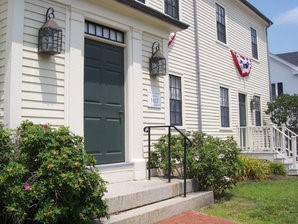
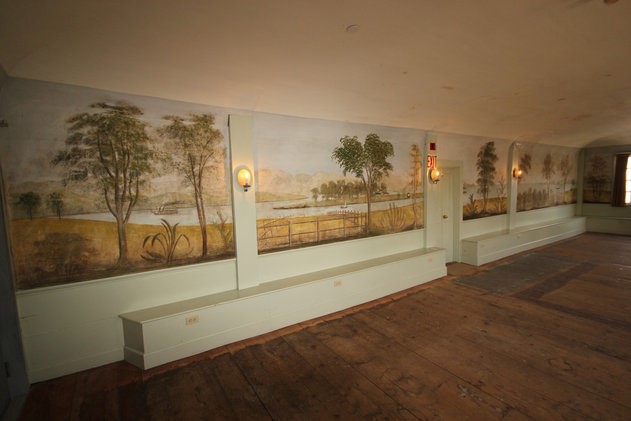
Porter’s massive folk art murals reach from the chair rail to the cove ceiling in the second floor ballroom. The murals grace each and every panel around the room. At some point in the history of the Damon Tavern, wallpaper was placed over the murals. The wallpaper was removed in the 1960s; and, at that time, the remarkable Porter murals were once again revealed to the town.
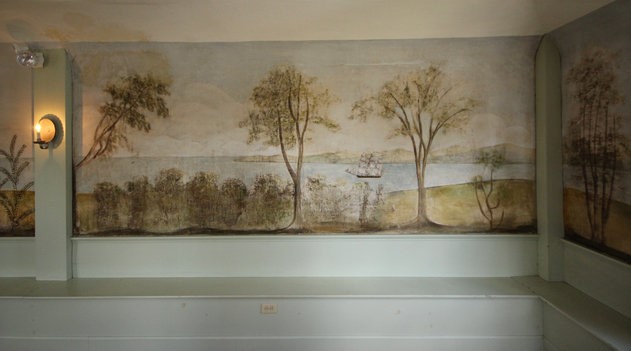
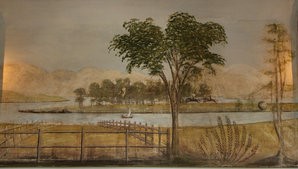
The murals in the ballroom at the Damon Tavern feature some of the “trademark” design elements and motifs of a Rufus Porter mural, including striking changes in perspective from enormous foreground trees to distant scenes of harbors, and cultivated hillside villages; sharp shading and highlighting on objects like houses, trees, fences, and foreground plants; billowing rounded clouds; sailing vessels of all sizes and shapes; and a little man dressed in top hat and tails sailing a small gaff-rigged skiff.
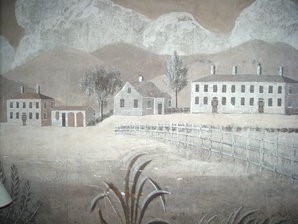
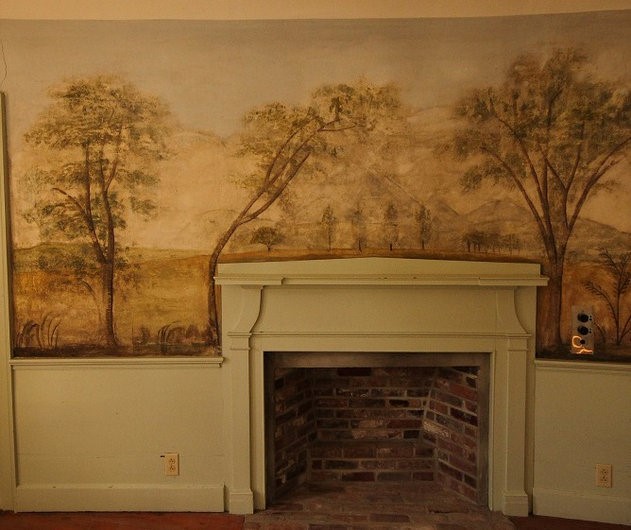
One of the panels in the ballroom features a mountainous scene with Porter’s often painted elm trees rising out of the foreground. Porter created a masterful aesthetic balance on this panel by having one of the Elm trees gracefully lean around the over mantel!
With his art, Porter touched the lives of rural New Englanders in a truly special way. At the Damon Tavern, he covered the walls in the ballroom with peaceful and serene New England landscapes and colorful vistas of rural life that spoke to the pride in America and the bounty of this young and plentiful country. Even during a cold and dark New England winter, Porter’s idyllic landscapes and harbor scenes surely brightened the hearts of all who entered the ballroom.
Welcome to the David Damon Tavern, oh weary traveler, and tarry awhile. And if a comfortable seat in a warm room, along with a hearty dinner renews your spirit, there is still time to join the fiddler in the grandly painted ballroom. Amidst the green hills and peaceful harbor scenes, may you twirl and whirl the night away!
These days, if you spend any time at the Damon Tavern, it is easy to contemplate the generations of New Englanders who might have passed through the doors of this venerable place. One can picture the weary travelers, itinerant painters, entertainers, traveling troupes, peddlers, preachers, and teachers, all gathering downstairs in the tavern and sharing their colorful stories. You might even hear rowdy exchanges along with the clanging of plates and utensils and the crackling of the fire. And don’t forget the sounds of the horses…who whinny and neigh outside the front door…heralding the arrival of new visitors. It is not hard to imagine that it might have been this kind of scene that welcomed Rufus Porter to the tavern so long ago.
The spirit of Rufus Porter is still strong even today in the ballroom at the tavern. Recently, a fund-raising event called “Paint like Porter” was held. Students learned about the methodologies and formulas Porter employed while painting scenic landscape murals, and then completed their own painting…surrounded by his almost 200 year old murals for inspiration. Currently, the Tavern is only open to the public on certain holidays and for special events. Contact damontavern@gmail.com if you have questions about the Damon Tavern, the Rufus Porter murals, or are interested in visiting the Tavern and viewing the murals.
The Center for Painted Wall Preservation, www.pwpcenter.org,
invites proposals for its
“Conserving the Painted Past” Symposium, slated for April 3-5, 2020 in
South Portland, Maine.
By bringing together presentations on recent and current case studies, the CPWP hopes to encourage and inform responsible practices for ensuring the survival of these vital pieces of our cultural history.
More information can be found at:
http:// www.pwpcenter.org/symposium.



